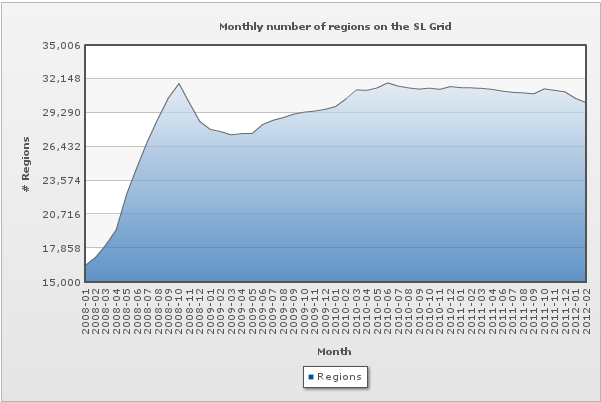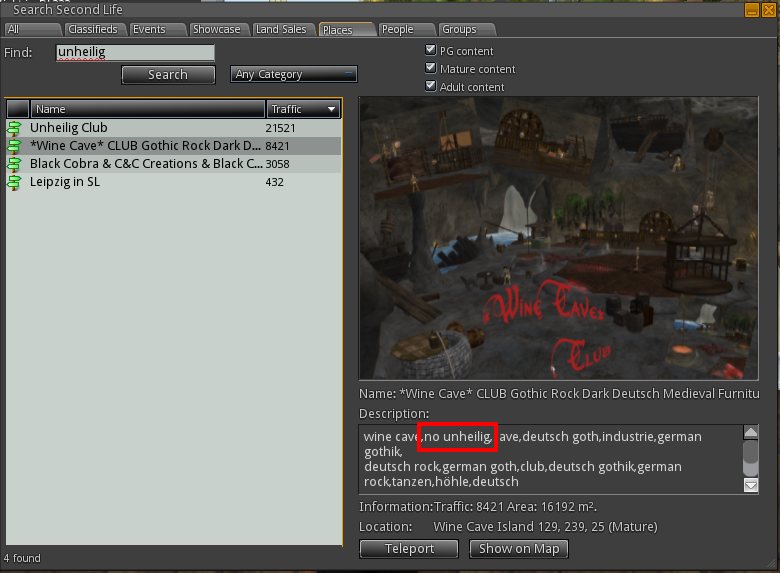Der alles beeinflussende Faktor, der über den wirtschaftlichen Erfolg von Second Life und damit bisher Linden Lab entscheidet, ist der Landpreis. Die Klagen der Bewohner, dass dieser im Vergleich zur vermeintlichen Konkurrenz Opensimulator inzwischen viel zu hoch sei, ist altbekannt, weit verbreitet und greift dennoch zu kurz.
Am Anfang war das Prim…
…und alle Prims sind gleich geschaffen worden. Zumindest kommt man auf diese Idee, wenn man sich die Landpreise ansieht: man bezahlt schließlich für jeden Prim, wenn man es umrechnet, für jeden Monat eine gewisse Miete und fertig.
Ein Simulator auf dem von Linden Lab betriebenen Mainland kostet monatlich 195 US$, es stehen dabei 15.000 Prims zur Verfügung. Ein Simulator, der abseits des Mainlands als private Region betrieben wird mit derselben Anzahl an Prims kostet im Monat 295 US$ (Einrichtungsgebühr nicht mit eingerechnet).
Mindestens 90% der monatlichen Einnahmen bekommt Linden Lab aus dem Geschäft mit der Vermietung von Simulatoren, es ist also der Fuß, auf dem das Unternehmen bisher ruht.
Nun ist es aber so, dass alle Prims eben nicht gleichwertig sind, sondern den Simulator unterschiedlich belasten können. Ein Prim, dessen sechs Seiten unterschiedlich texturiert sind, dazu noch physisch ist und 20 aktive Skripte hat, benötigt nun einmal mehr Serverleistung als ein Standardprim mit der Plywood-Textur.
Aber diese Unterschiede spiegeln sich bisher nicht in der Mietsgebühr nieder, das bisherige Versprechen ist immer „Du zahlst für alle Prims dasselbe und was du dann damit machst ist dein Bier“ gewesen. Das hat auch lange Zeit recht gut funktioniert, ist aber inzwischen überholt und auch Linden Lab selber kommt davon so langsam ab, wenn man sich die Berechnungsgrundlagen der Primäquivalenz für Meshbauten anschaut.
So oder so bedeutet die Abhängigkeit dieser Mieteinnahmen, dass unser aller Vergnügen direkt erst einmal von den Simbesitzern finanziert wird und indirekt durch all diejenigen, von denen sie Geld einnehmen. Gäbe es diese Mieteinnahmen – die geschätzt etwa 5 Millionen US$ im Monat betragen – nicht, dann gäbe es auch kein Second Life. Diese Einnahmen also halten Second Life am Leben und am Laufen, zu unserer aller Zufriedenheit.
Software as a Service oder: von den Mieten hängt viel mehr ab, als man meint
Wenn man die Mietgebühr einer Sim in Second Life mit der eines Simulators eines beliebigen Opensimgrids vergleicht, dann wird Second Life immer verlieren, da es diese Preise nicht bieten kann noch können wird.
Diese Vergleiche sind einfach, erscheinen logisch und sind schlichtweg falsch. Es ist das Vergleichen von Äpfeln mit Birnen.
Was viele bei diesen einfachen Vergleichen nicht berücksichtigen ist, dass an der Mietgebühr in Second Life mehr als nur der Betrieb des Simulators hängt. Von diesen Einnahmen wird der Mitarbeiterstab finanziert, darunter alle Programmierer, und schon alleine diese kosten einiges. Linden Lab leistet nach wie vor Pionierarbeit, muss alles selber programmieren und das schlägt sich darin nieder. Dazu kommt, dass auch die Infrastruktur, die zum stabilen Betrieb von Second Life notwendig ist, nicht gerade billig zu bekommen ist. Alleine die Kosten für den Assetserver dürften sehr hoch sein, dazu kommen die massiven Leitungen ans Internet verbunden mit dem Support und vielen, anderem mehr. Das sind alles Punkte, die in die Mietgebühr mit einfließen und aus dieser finanziert werden.
Eine einfache Opensim ist natürlich billiger zu haben, ganz einfach weil die Software – die erst durch Linden Lab so schnell so weit kommen konnte – billig zu haben ist, und die Programmierer in vielerlei Hinsicht keine Pionierarbeit leisten mussten, sondern auf den Schultern Linden Labs standend bereits von deren Erfahrungen und Leistungen profitierten. Man stelle sich mal nur alleine vor, Linden Lab hätte niemals seinen Viewer als Opensource freigegeben, die Community von Opensim alleine hätte die Programmierung eines solchen sicherlich niemals selbst geleistet.
Dazu kommt, dass bisher kein OS-Grid auch nur annähernd die gleichzeitige Benutzerzahl und Größe des Assetsystems wie bei Second Life erreicht hat, also technisch gesehen ein viel geringerer Aufwand getrieben werden muss.
Damit ist es natürlich klar, dass Opensim preislich gesehen Second Life gnadenlos unterbieten kann, weil die Betreiber solcher Grids einfach sehr viele laufende Kosten in der Höhe, die Linden Lab hat, nicht haben.
Allerdings ist es nach wie vor so, wer nach Opensim geht, leistet Pionierarbeit und darf sich von seinem bisherigen Content verabschieden. Das, was man nach wie vor in SL hat, ist sehr viel guter Content in allen Formen und soziale Interaktion. Opensims sind vereinzelte Inselchen, Second Life dagegen eine Kleinstadt. Beides hat seine Berechtigung, aber hier Äpfel, da Birnen.
Der Rückgang der Mieteinnahmen
Viele sind der Meinung, das Second Life momentan vergleichbar mit AOL ist: es ist zwar nach wie vor irgendwie profitabel, aber hauptsächlich durch den vorhandenen Benutzerstamm, der kaum noch spürbar wächst – und es ist es damit nicht nachhaltig.
Dass die Mieteinnahmen bestenfalls stagnieren ist eine Tatsache. Dazu muss man sich nur einmal die Zahlenwerke von Gridsurvey ansehen, nach denen Second Life im Moment leicht schrumpft. Diese Schrumpfung war 2011 zwar nicht massiv, aber spürbar genug und damit verbunden natürlich auch geringere Miet- und damit wiederum Gesamteinnahmen für Linden Lab.
Die Folgen? Zweierlei!
Durch die sinkenden Mieteinnahmen gerät Linden Lab langsam, aber sicher in eine Bredouille: die Server dürften geleased sein. Das bedeutet, wenn Sims leer laufen oder nicht vermietet werden können, die Rechner gar abgeschaltet werden, müssen dennoch weiterhin die Raten für diese abbezahlt werden, sie verursachen also auch so als laufender Posten Kosten, wenn sie nicht genutzt werden, und das ist schlecht für das Unternehmen. Dazu kommt, dass die Rechenzentren natürlich auch weiterhin ihre Dienste als Colocation bezahlt werden wollen.
Oder einfacher gesagt: die Einnahmenseite sinkt, aber die Ausgabenseite bleibt ziemlich konstant. Das heißt nichts anderes, dass man hier Gefahr läuft, sollte man nicht entsprechende Gegenmaßnahmen ergreifen, als Unternehmen Verluste zu schreiben. Natürlich könnte man die Ausgabenseite kurzfristig senken, indem man Mitarbeiter entlässt, den Support auslagert und ähnliche Scherze betreibt, aber meistens schaden solche kurzfristigen Maßnahmen einem Unternehmen auf Dauer mehr als sie ihm nutzen.
Eine Möglichkeit, um dem entgegen zu wirken, ist einfach wieder das Produkt „Second Life“ an sich bekannter zu machen und dafür zu sorgen, dass mehr wirkliche Neulingen nach Second Life kommen und vor allem dann auch auf längere Zeit bleiben! Linden Lab hat in der Tat so einiges probiert, das zu erreichen wie z.B. den mißglückten Viewer 2, die Aufwertung der Premium-Accounts, und und und…
Die zweite Möglichkeit besteht in der Diversifizierung der Einnahmenseite; wenn man mehr als ein Produkt hat, das man verkauft/vertreibt, dann steht die Firma insgesamt auf mehreren Standbeinen und wird stabiler. Die Entwicklung neuer Produkte kostet dabei natürlich Geld, es ist aber an und für sich eine gute Idee, nur müssen diese Produkte dann auch nachgefragt werden. M Linden suchte sein Glück mit Firmenlösungen im Bereich 3D-Welten und scheiterte.
Rodvik Linden nun selber setzt auch auf neue Produkte, die für dieses Jahr angekündigt worden sind, was sie aber genau sein werden, darin hüllt er sich bisher in Schweigen.
Dass übrigens Linden Lab auch nicht genutzte Simulatoren ziemlich sicher Kosten verursachen kann man daran erkennen, dass es vor einiger Zeit ein Sonderprogramm gab, in dem die Einrichtungsgebühren für Sims radikal gesenkt waren.
Das Fazit
Ich gehe davon aus, dass Linden Lab momentan noch profitabel arbeitet, also einen Gewinn in welcher Höhe auch immer erwirtschaftet. Die Frage ist wie lange noch und was wird mit diesem Gewinn gemacht.
Der finanzielle Spielraum und damit Gewinn von Linden Lab ist sehr stark an die monatlichen Mieteinnahmen gekoppelt, und hier dürfte es langsam eng werden. Momentan ist die Firmenpolitik von Linden Lab, das verfügbare Geld hauptsächlich in die Entwicklung neuer Produkte zu stecken. Das macht Sinn, um das unternehmerische Risiko breiter zu streuen und die Firma insgesamt auf gesündere Beine zu stellen.
Nur: wer wie Linden Lab in neue Produkte investiert, der wird dies – solange er es denn kann – lieber aus eigener Kraft tun als dafür kostspielige Kredite aufnehmen zu müssen. Linden Lab ist nicht an der Börse notiert und kann daher auf solchem Wege kein Geld bekommen.
Das alles führt dazu, dass Linden Lab es sich momentan nicht wirklich leisten kann, die monatlichen Mietgebühren zu senken.
Auch hier gilt natürlich nach wie vor, dass Angebot und Nachfrage den Preis bestimmen, aber einen wirklichen Konkurrenten zu Second Life gibt es nicht und damit ist Linden Lab in dem Bereich Quasimonopolist. Opensimulator ist noch lange nicht soweit, als dass es Second Life direkte und schwere Konkurrenz bereiten könnte, vielmehr besetzt es bisher nur Nischen, in die Second Life nicht vorgedrungen ist oder diese nicht mehr bedienen mag.
Daher bleibt uns das Preisniveau auf längere Sicht erhalten, Spielräume nach unten gibt es kaum und wirklich ändern wird sich daran erst dann etwas, wenn Linden Lab massiv mit anderen Produkten Geld einnehmen wird und/oder ein ernsthafter Konkurrent für Second Life auftaucht. Vorher aber nicht.

